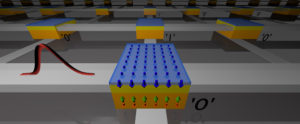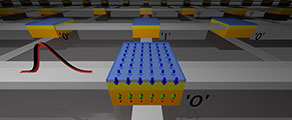A new discovery by researchers at the Department of Energy’s Lawrence Berkeley National Laboratory (Berkeley Lab), UC Berkeley, and UC Riverside could lead to non-volatile, energy-efficient computer memory without sacrificing speed.

In this schematic of a magnetic memory array, an ultrafast electrical pulse switches a magnetic memory bit. (Credit: Jon Gorchon)
The scientists developed a method for electrically controlling magnetism in certain metals at much higher speeds than in today’s magnetic random access memory (MRAM) on the market. They found that in a magnetic alloy made up of gadolinium and iron, fast electrical pulses can switch the direction of the magnetism in less than 10 picoseconds, which is orders of magnitude faster than current MRAM technology.
To see if the switching could be expanded to a broader class of magnetic materials, the researchers found that stacking a single-element magnetic metal on top of the gadolinium-iron alloy. The interaction between the two layers allowed them to manipulate the magnetism of the cobalt on “unprecedented time scales,” the researchers said.
The work was led by Jeffrey Bokor, a senior scientist at Berkeley Lab’s Materials Sciences Division and UC Berkeley professor of electrical engineering and computer sciences. The findings are described in the journals Science Advances and Applied Physics Letters.
“These two discoveries provide a route toward ultrafast magnetic memories that enable a new generation of high-performance, low-power computing processors with high-speed, non-volatile memories right on chip,” said Bokor.
The National Science Foundation and the Department of Energy Office of Science supported this work.
Read the full press release here.
